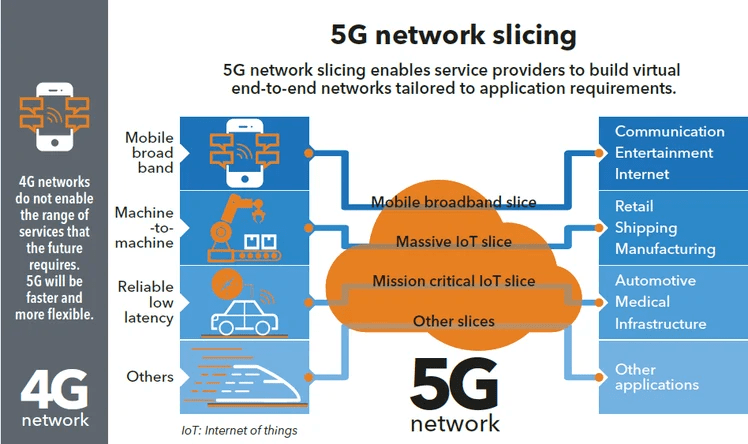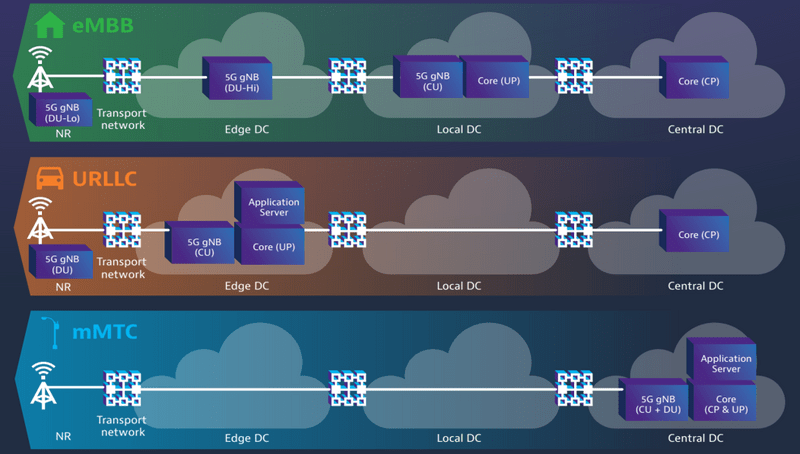Network slicing is dividing the network into multiple virtual connections which can be tailored to the traffic requirements of different use cases. With 5G around the corner network slicing in 5G has been an important focus. Network slicing is advertised as a fundamental capability of 5G. The blog will help us understand 5G network slicing architecture and working, network slicing challenges and opportunities, security with slicing in 5G and 5G network slicing examples.
Contents
What is network slicing in 5g?

The 5th generation of networks comes with the unique capability of network slicing which was not possessed by any of the earlier generations. It is a capability that allows service providers to deploy specific services to support the requirements of different customers and market segments. Network slicing utilises network virtualisation for dividing the single network infrastructure into multiple virtual connections. These virtual connections can then be provided to enterprises with the benefits of customisations while ensuring compliance with service legal agreements (SLAs).
The key differentiators for this offering are cost reduction, automation and flexibility. The network slice can be managed in such a manner that it can be dedicated to one customer or to multiple. Slicing ensures that each connection has its own architecture, security and management to support different use cases.
How does network slicing work in 5g?
5G cloud-native network (5GCN) is an essential requirement for network slicing in 5G. 5GCN is equipped with specialised network nodes for network slicing. These network nodes are responsible for allocating radio resources to devices based on the service agreement.
5GCN needs to employ a service-based architecture. Adoption of a service-based architecture is necessary for managing the network resource allocation to devices across enterprises based on the agreed service requirements.
To allow a user device to be connected to multiple slices the 5G network consists of a large number of nodes specialised in network slicing. The primary node performs the function of the network slice selection function (NSSF). Apart from this the access and mobility management function (AMF) works in tandem with the NSSF to determine the network slices application to each service agreement.
5G network slicing: Architecture

5G network has the potential to meet diversified needs. The services are broadly classified into three categories:
- Enhanced Mobile Broadband(eMBB)
- Ultra-reliable and Low-latency Communications (uRLLC)
- Massive Machine Type Communications (mMTC).
The network slicing architecture in 5G requires a network slicing software-defined network (SDN) and network function virtualisation (NFV).
The SDN performs the role of managing the traffic flow through the application program interfaces (APIs) of the central control plane. Through the application layer, the control plane configures the resources to offer customised services as per the requirements. An infrastructure layer is also part of the SDN, which incorporates fundamental network services and is responsible for data forwarding and rule processing from the control plane. The network slice controller (orchestrator) is in charge of mapping services and monitoring functionality across layers.
SDN enables the creation of a slice consisting of specific resources. The creation of multiple sub-controllers to support slice composition is done with the help of recursion.
The other part of the architecture is network function virtualization. It allows the installation of network functionality on virtual machines. NFVs manage the lifecycle of network slices and infrastructure resources.
What is the significance of network slicing?
While 5G is the next step in the evolution of mobile networks, it stands out from being just another radio access network model because of network slicing. Network slicing operates by applying virtualization principles to mobile networks. While this could prove to be the next disruption in the industrial revolution 4.0, debates over the urgency and significance of network slicing are ongoing. Before we deep dive into a list of the pros and cons, let us go over a basic introduction.
The simplest possible way to describe network slicing is horizontal virtualization with an approach centred around combining the following:
- The 5G New Radio (NR) network
- Software-Defined Networking (SDN) technology
- Network functions virtualisation (NFV) architecture
These create various self-sufficient network slices facilitating communications service providers (CSPs) to segregate users, machines, and purposes that demand a distinct quality of service (QoS). The applications of these slices can extend to offering mobile network administrators’ individual virtual infrastructure, which could go a long way in enhancing MVNO-based services.
Horizontal slicing provides cross-application and cross-service division of networks. Individual horizontal slices have their respective virtual resources detached from those employed for different slices.
This makes horizontal network slicing different from contemporary network division, also known as vertical slicing. The resources are not segmented as much in these cases and are allocated based on the use case.
What are the major drawbacks of 5G network slicing?
While network slicing holds tremendous potential for 5G networks, it has its fair share of hurdles. While there is agreement on the pivotal role of network slicing in 5G, the procedure for its implementation needs to be figured out.
- As 5G networks offer wireless connectivity, it will be essential to re-design Radio Access Networks (RANs) for network slicing. Network slicing is typically applied in the central network region of the 5G network and can be executed in the RAN segment by combining resources. However, for 5G network slicing to be viable, multiple macrocells and small cells need to work in unison to satisfy the requirements of various network slices.
- Understanding how best to enable point-to-point connectivity between mechanical controllers and radio devices by combining network slicing with NFV and SDN needs to be established.
- While the solitary nature of the deployed technology may restrict interference from network slices, achieving point-to-point connectivity is a challenge with an excess of network slices.
- Ensuring network slicing can work with emerging 5G technologies requires extensive interoperability as networks gradually transition to 5G. Communication service providers and network operators must test the interoperability extensively to ensure network slicing works as expected in 5G networks.
- Industry experts need to agree on the best route for implementation, which will take some time.
- While 5G network slicing leverages an intelligent use of standard radio resources, it needs advanced techniques to guarantee the isolation of these radio resources.
Security with 5G network slicing
Network slicing increases network complexity which has security implications. Every network slice carries a different amount of traffic and hence has unique security requirements. The scalability that can be achieved with the help of slicing also opens doors for potential network threats. An attack on the central infrastructure can hamper multiple slices at the same time.
Another security challenge that network slicing presents is data isolation. Protection of information being used on one network slice from being modified by another on the same infrastructure will be a challenge for the operators.
SDN and NFV are also potential threat areas. Attackers can analyse the processing time of a packet using the SDN’s input buffer. Security threats around NFV include attacks on the orchestration management systems, denial of service attacks etc.
Close coordination between operators and enterprises is essential to maintain secure communication across slices. This will ensure the protection of the privacy of users while maintaining the quality of service.
Use cases
Some of the use cases of 5G network slicing are:
- Autonomous cars: Slicing will allow customising the networks to match the infrastructure, technology and regulatory requirements of autonomous cars. The dedicated network slice will help in ensuring superior quality of service with adequate network resources.
- Gaming: Intense matches and gameplays require uninterrupted connectivity with low latency for a hassle-free user experience.The network resources can be customised to suit the traffic requirements of gamers to ensure an enriching gaming experience. Steady connectivity will help maintain competitiveness in the gaming world.
- 5G surgery: Remote surgery has been one of the breakthrough use cases identified with 5G. Doctors can control robotic arms to perform high-risk surgeries from anywhere in the world. But with the matter of life and death, seamless connectivity is of utmost importance. The network slicing in 5G ensures that dedicated network resources are available for performing surgeries.
- Sports: The world of sports is being transformed with new technologies being introduced to reimagine the fan experience. Smart stadiums and being built and technologies like holograms, augmented reality and virtual reality are being leveraged to change the fan experience at home and at the stadium. With dedicated slices for different stadiums, new technologies will take fan engagement to the next level.
- IoT slices: IoT devices are being used for applications varying from smart cities, inventory management, and health monitoring to smart homes. The amount of data generated by these devices necessitates the requirement of undisturbed connectivity with minimum latency. Network slices enable this by providing the freedom of customisation to suit individual requirements.
FAQs
What is meant by network slicing?
The creation of multiple virtualised and logical networks over a common physical network architecture is known as network slicing. Each slice is capable of supporting different amounts of traffic by providing different amounts of network resources. Network slices open up a large number of use cases. Network slicing modifies the entire network by abstracting, isolating, orchestrating and separating the logical network components.
What is 3GPP network slicing?
3GPP defines network slicing as, “A network slice is viewed as a logical end-to-end network that can be dynamically created.”Business models for network slicing are highlighted in release 16 of 3GPP in TR 21.916.
Why is network slicing important?
The return on investment for network operators is maximised for network operators with network operators. This happens because of the efficient management and allocation of network resources at scale.
While on the other hand network slicing allows the adoption of a large number of use cases by customising the network resources to support specific requirements.















